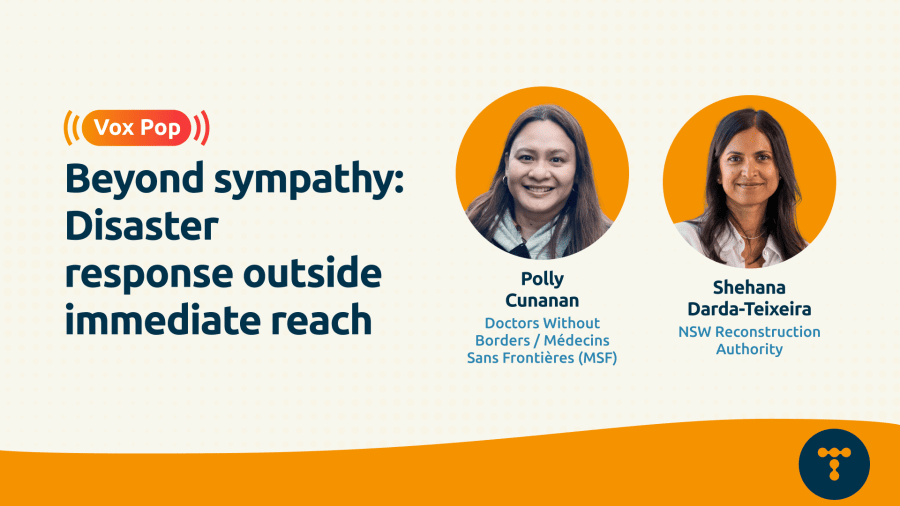From flash floods and bushfires to typhoons and volcanic eruptions, the Asia Pacific region has become increasingly susceptible to a wide spectrum of natural disasters in recent years.
Beyond the immediate human, environmental, and economic impact, natural disasters can provoke complex questions even for organisations that are not immediately affected by the event. For communicators, it’s considering questions like "when and how should we respond?" and "what role do we play?" when a crisis unfolds outside of an organisation’s immediate operations.
To explore these issues, Telum Media spoke to Polly Cunanan, Head of Communications, APAC at Doctors Without Borders / Médecins Sans Frontières (MSF), and Shehana Darda-Teixeira, Executive Director Communications and Engagement at the NSW Reconstruction Authority, to look into the role of distant voices in natural disaster crisis communications.
To respond or not to respond?
For MSF, Polly said that the decision to make a public statement is rooted in the principle of 'témoignage,' which means 'bearing witness' to what its teams see on the ground.
"We generally do not comment on crises where we lack a physical presence, as we cannot ground our communications in medical evidence or what we directly witness ourselves alongside our patient care," she explained.
Polly outlined several factors that they consider before making a public response:
- Operational impact: Can communications jeopardise the safety of patients and staff, or hinder current or future medical activities? If there's a significant risk, the organisation may choose to delay or refrain from making public statements.
- Strategic opportunity: Can communications help access affected areas, build support for emergency response, or catalyse action?
- Alignment with social mission: Communications must reinforce MSF’s core social mission of medical and humanitarian assistance. Public statements are always evaluated through that lens.
This approach shaped MSF's communications during the 2024 storm season in the Philippines, when six storms hit in a single month, two of which required emergency responses.
"Within days of the storms making landfall, our teams were on the ground with mobile clinics reaching patients who had lost homes, suffered injuries, and needed medication," Polly said.
"In our communications, we spoke about the health needs that emerge not only in the immediate aftermath but in the weeks that follow."
For Shehana, clarity of purpose is equally essential in natural disaster communications.
"Are you sharing public information that will help people in trauma, or do you just want to acknowledge what has happened?" she asked.
Shehana noted that organisations need to consider factors such as whether they have a connection to the event, if silence could be perceived as indifference, and what the local cultural and political contexts might be.
Before deciding to respond publicly, organisations should also be aware of what information has already been shared by other organisations and government agencies.
Striking the right tone
Once an organisation decides to respond to a natural disaster, both Polly and Shehana emphasised that communications must serve affected communities, not organisational positioning.
Shehana stressed that recovery communications differ significantly from "business-as-usual" campaigns.
"The key is working out what people in trauma need and sharing public information that is useful," she said.
She pointed out that during trauma, people process information differently. This means keeping language simple and accessible, repeating key messages, being transparent about the known and unknown, and ensuring messages respond to community needs and concerns.
Polly added that for MSF, empathetic messaging is not simply about what is said - but how, when, and why it is said.
"Our messaging is always intentional. Every word must serve the people at the heart of our work."
The organisation's public communications follow three guiding principles:
- Purposeful: Every statement should support MSF’s mission. The organisation does not speak out to promote itself, but to advocate for access, protection, and dignity for patients.
- Patient-centred: When sharing patient stories, consent and respect are essential. The aim is to elevate voices, not exploit suffering - which requires careful consideration of language, context, and tone.
- Respectful: Timing and relevance are critical. In a crisis, will the organisation’s voice add value or risk distraction? Will it protect dignity or avoid harm?
Adjusting internal and external activity
Natural disasters also have implications for business operations and messaging. At MSF, disasters immediately take precedence over regular business activities.
"In the wake of a disaster, we quickly assess the situation and determine our priorities," said Polly.
"Once these are clear, each team can adjust its activities to serve those priorities - whether that’s raising additional funds for the response, raising awareness around the plight of a community, or denouncing failures to adequately provide for those in need."
Shehana stressed the importance of early alignment across teams.
"Engage your leadership team early and get alignment on priorities, tone, and any operational changes that may be needed."
She also highlighted the need to pause or adapt scheduled content that could come across as insensitive, ensure consistency across channels, and support frontline staff with clear messaging.
As part of her work as Co-Chair of the NSW Government's Crisis Communications Committee, Shehana coordinates with all agencies to ensure alignment in government messaging during and after disasters. Having centralised internal communications in place allows for further reach and success in comms efforts as compared to when teams work within their own channels.
The craft of considerate and conducive external messaging in response to natural disasters will remain a challenge to comms teams across Asia Pacific. But as Polly and Shehana highlighted, they can be navigated by keeping a few key principles in mind: responding with purpose, putting communities at the heart of messaging, and ensuring business activities stay aligned and adaptable.
When a crisis impacts people and livelihoods, the task for organisations outside of the affected areas is not just to respond. More than sympathy, communication teams must ensure that the organisation they represent is responding in ways that provide clarity, compassion, and genuine value to those affected.



